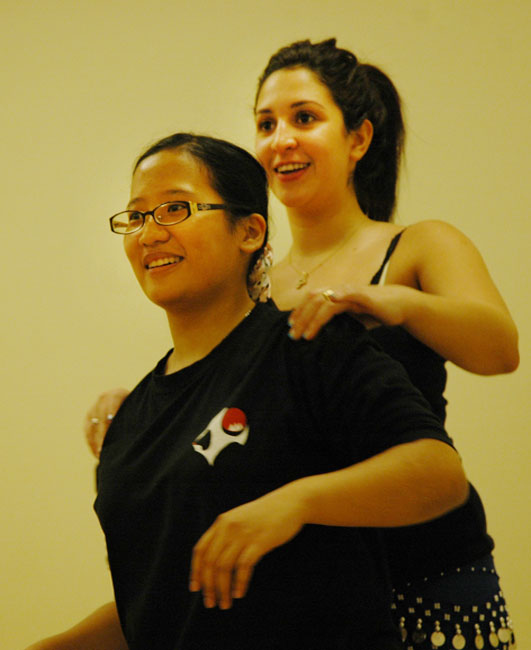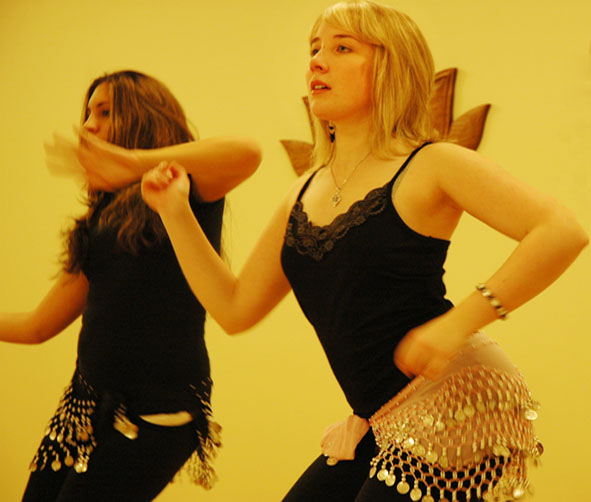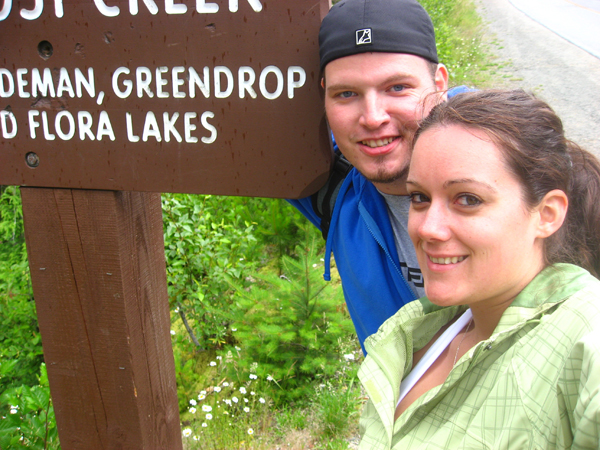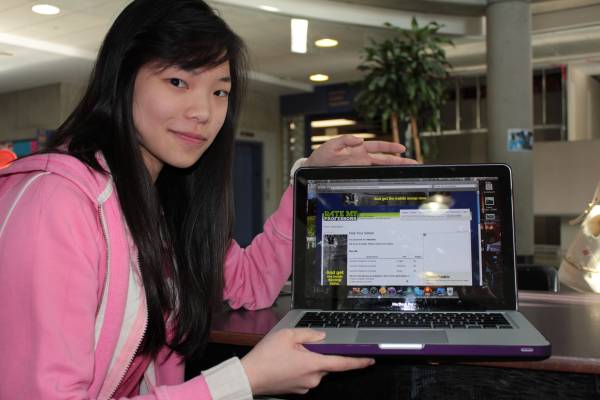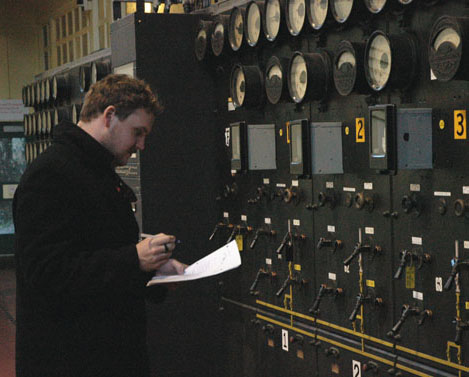Passion for Dancin’
November 21, 2010 by Jocelyn Gollner · Leave a Comment
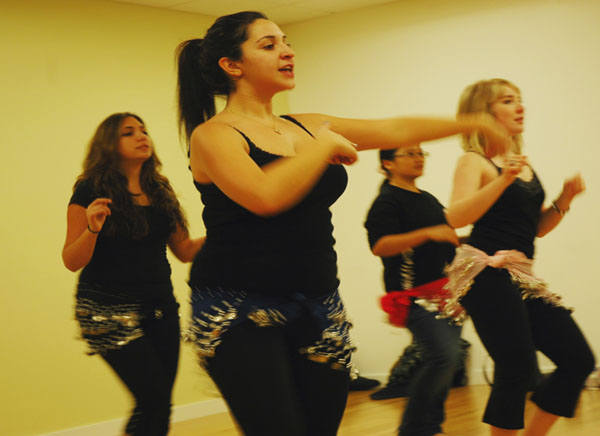
Meirna Said teaches the Passion for Dancin' club at the Richmond campus on Thursday. (Photo by Meagan Gill)
Kwantlen students are showing they have a Passion for Dancin’.
Passion for Dancin’ is a new club at Kwantlen that allows students who like to dance the opportunity to learn a variety of cultural dances, including bellydancing, salsa, bachata and merengue.
Meirna Said created the club only about a month ago, although she has been seriously thinking about it since last year.
“What I got from [the club members] is that they wanted a workout and learning how to dance, and that’s what I want to give them. I want to give them fun, enjoyment and learning with it,” Said said.
The Dance Towards Peace Organization, which Said represents, was what inspired her to start the club. The organization “tries to promote peace through dancing. And especially through children. So we used to try to teach children how to dance. We used to go to the cancer hospitals…and teach them how to dance. And we found out it was great because with dancing you can do anything,” Said said.
Next week, club members will be learning how to dance salsa and they’ll be going to a salsa night somewhere in town during the week, to see first-hand what salsa dancing is like.
The club meets every Thursday night from 7 to 8 p.m. at the yoga studio on the Richmond campus. A fee of $30 is charged for the club for the whole semester, and goes towards the Breast Cancer society.
Video: What is your Lucky Charm?
November 15, 2010 by Brittany Tiplady · Leave a Comment
Kwantlen students and others were asked what they use as their lucky charm, whether for midterms, final exams or daily life. A video by Brittany Tiplady and Paul Fleischanderl.
College-age students: taking the soulmate search on-line
November 14, 2010 by Miranda Gathercole · Leave a Comment
By Miranda Gathercole and Sarah Casimong
Finding a soulmate can be tough.
When the club and bar scenes aren’t cutting it and Mr. Right hasn’t managed to pop up in everyday life, some, including university students, are turning to the internet for dating. In fact, last year the Boston Globe reported the use of online dating among college-age students is rising.
Emmeli Rosenberg Lassesen, 25, had a difficult time finding the right guy. She found that looking at options online allowed her to narrow the field down a good match.
“I’m tall, so I think for me that was one of the things that’s hard to find when [I] meet people, ’cause I like taller guys,” said Rosenberg Lassesen.
“I’m just slightly under six feet. So you know if you go out to the club with your girlfriends and you’ve got your high heels on and you’re 6’3, 6’4, you kind of don’t get approached by many guys.”
For four years she experimented with profiles at different on-line sites, including eHarmony and Lavalife. In the end, she found PlentyofFish to be the best option because of a variety of people and free profiles. (Lavalife and eHarmony offer some tools for free but require subscriptions that have a base rate of around $15 to $20 a month.)
“There really actually isn’t a difference [between free and paid sites],” said Rosenberg Lassesen. “Some people think that there would be a difference, because if someone was paying for the site, they’re more looking for something, but the quality of people between a free site and a paid site was the exact same. There was no difference at all, which I found out after spending the money.”
PlentyofFish.com is a free online dating engine, based in Vancouver, that matches couples based on their written descriptions of goals and aspirations, what makes them unique and their taste in music. The site boasts, “Over 32,000 couples have sent in a testimonial telling us how PlentyofFish helped them find their soulmate.”
Four months ago, Rosenberg Lassesen found success on the site when she met her boyfriend, Adam Gill.
“He messaged me first. I’ve done the online dating thing for a while and I’ve always just had a policy that if a guy likes me he’s gonna message me. I’m kind of old-fashioned,” she said.
“The big thing for me is I wouldn’t add someone on Facebook until I talked to them on MSN for long enough that I felt I had a good gauge of who they were. If you add someone on Facebook, they have your last name so there’s a safety issue with that.
“I actually wouldn’t give out my number very easily to people. I would sort of leave it. I’d actually talk to them for a couple of weeks on MSN and if we were going to meet up I’d [suggest] somewhere public. Even if they offered to pick me up, I’d always say ‘I’ll meet you there.’ It’s common sense that you have to use for safety. If you don’t use your common sense, what do you expect?”
Other popular dating sites include Match.com, lifematescanada.com, and Okcupid.com.
Kwantlen scores low in student ratings
November 14, 2010 by Josh Saggau · Leave a Comment
When it comes time to select classes for the next semester, it can be hard to know what each class is going to be like. To help, students have ratemyprofessors.com.
The site, which was started in 1999, has compiled over 11 million student-based rankings of teachers at more than 6,000 schools in the United States, Canada, England, Scotland and Wales to help students find the kind of professor they are looking for.
“It helps students to know more about their instructors. We hope to find an instructor that works for us. I think that it’s beneficial for students,” said Sandy Wong, a Kwantlen human resource student.
The site asks students to rate current and past teachers on easiness, helpfulness and clarity, so that future students can get a feel for the type of teacher they are going to have even before they step into the classroom.
“I know some students check it before they enrol in class to see who the professor is and it kind of sways if they are going to enrol in that class,” said Caitlin Penberthy, an environmental protection program student.
Kwantlen’s average ratings on the site are quite low compared to other universities in the Lower Mainland. While SFU, UBC and UFV have average ratings of 3.24, 3.29 and 3.54, Kwantlen is averaging just 2.7.
“It’s subjective. If you don’t get a good mark, then obviously you’re going to be upset and write something that’s not so great. I would hope that if teachers look at it, they would understand it’s subjective,” said Penberthy.
Kwantlen’s aboriginal club ready for action
November 14, 2010 by Sarah Casimong · Leave a Comment
Kwantlen’s aboriginal group may have just been made offical on Friday, but it already has great plans.
“We generally just have a lot of fun and get to know each other,” said Melinda Bige, main contact person for the Aboriginal Students Club. “Right now we are just in the bare beginnings…we’re just trying to organize events around what the students want to do.”
Members of the club, which meets Wednesdays at 4:30 p.m. at Kwantlen’s Aboriginal Gathering Place, have already come up with ideas for members, including ultimate frisbee and a canoe trip.
“They want to do fundraising for a canoe trip. That’s traditional to the Semiahmoo tribe and very spiritual,” said Bige, adding that they hope to do it in the summer.
In addition to recreational activities, the club also has big plans to get involved politically.
“The more political [students], like myself, want to do conferences on indigenous rights and stuff around the world. Right now, we just participated in a campaign for GIA, which is Global Indigenous Youth for Action. It’s part of the United Nations. We just took some pictures with some signs that support the group,” she said.
The priority for the club is also to provide education on aboriginal culture and issues.
“We have a lot of urban aboriginal students, so they’re just relearning their own culture, like myself,” said Bige. “We talk about aboriginal issues, too. I’m planning on showing Kevin Annett’s documentary on repentance.”
Although the club’s focus is on aboriginal culture and identity, Bige said membership is not limited to aboriginals, and encourages people of all ethnicities to drop by.
“It’s also not culturally exclusive, so everyone can be involved. You don’t have to be aboriginal.”
On Nov. 17, the club will meet at 4 p.m. at the Grassroots Cafe instead of the gathering room. For more information, contact Melinda Bige at melinda_bige@hotmail.com.
Kwantlen student turns the tables on stereotypes
November 14, 2010 by Brittany Tiplady · Leave a Comment
At the age of 18, most are struggling to a decide whether to enter post-secondary school or to continue living off the bank of mom and dad.
But, at 18, Raedel Campbell has already graduated from high school, is well into her first semester at Kwantlen, and has given birth to a child.
“It was February 2009 and I was in school, so I was young. Grade 11 I found out, actually,” said Campbell. “With my parents, at first, it was a bit of a fight, but they realized I am pretty stubborn because I wanted to keep the baby. So they decided not to stress me out, because that’s bad for the baby, and became totally supportive, and were totally excited to be grandparents.”
The pregnancy did not stop Campbell from completing high school in the most normal fashion possible. “I did get to go to grad, I have my diploma. It was all on time so I am not behind at all,” she said.
Campbell is now attending university, working and attempting to maintain a social life, all the while raising one-year-old Hayley.
“I have been [at Kwantlen] since September, and I am in the arts program, but I am just taking some electives toward a social services diploma that I will be transferring to UFV to complete, hopefully next year,” said Campbell. “I have four courses right now: Creative writing, English, anthropology, and communications, and it’s tough to handle for sure.”
Campbell’s experience with young motherhood has steered her career aspirations.
“I want to be a family support worker, and eventually work up my way and try to help out young moms, cause I’ve been through it. That’s what has inspired me,” she said. “I wanted to be a chef for a really long time, and after I had my baby, and went to a young parents group, I realized I wanted to help other young moms. I know I am someone they could relate to. And I want to be a really good mom, I want to have more kids, so I would need a good career to do that.”
“Teen moms” carry a negative stereotype, especially in the eyes of judgmental teens in high school hallways. But Campbell has fought to sustain a positive disposition and confidence in her decision.
“When I was first pregnant I’d get stared at, and people would be like, ‘Oh, what’s she thinking?’ I would get very upset about it. But then I realized I am not a normal young mom. A lot of them don’t go to school, and I know I am doing everything I can to provide a good life for my daughter. I am going to work, I am going to school, and I graduated on time. So I just kinda laugh, because they can put any stereotype on me, but I know it’s not true,” she said.
Content with the direction that her life has taken, Campbell says she wouldn’t change a thing.
”I’ve been pretty happy with everything. I think it’s the best thing to have happened to me. The father and I are actually back together and engaged. So things have gotten better between us.
We weren’t together for the entire pregnancy, and as hard as things were, it was the best for both of us not to be together,” she said.
With movies such as Juno, and TV shows such as “The Life of an American Teenager,” teen pregnancy has been brought into homes as a reality, but there’s also a stigma of what it means to be a teen mom. Campbell, with unwavering confidence, has taken it on herself to overcome all of that.
Her advice for other young moms and dads, enduring her same struggle is simple: “Keep your head up. Keep pushing because you can’t let other people get you down. Keep your dreams intact.“
Video: Who pays when you’re on a date?
November 8, 2010 by Jocelyn Gollner · Leave a Comment
Jocelyn Gollner, Miranda Gathercole and Sarah Casimong explore what Kwantlen students think about traditional gender roles in dating. Students voice their opinion about what they think about the expectation of guys having to pay on dates and whether it’s out of a woman’s place to be forward.
Environment students embark on a dam field trip
November 7, 2010 by Stu Gallacher · Leave a Comment
Physics students from the environmental protection technology program at Kwantlen woke up at the crack of dawn on Thursday for a field trip to the hydroelectric dam at Stave Falls.
Eight second-year students and one professor arrived in the Richmond campus parking lot to board school bus for a 7:30 a.m. departure to Mission where the dam is located.
The original Stave Falls dam has been out of commission since 2000, but remains open to the public as a museum, which provides educational and entertaining tours.
“I enjoyed the tour and the dam was interesting, but it was an early time for a field trip,” says Neil Brooks, who is a second-year student.
“It’s all about learning application and seeing real life examples of what we study in class,” says John Currie who is also a second-year student.
The EPT students have been studying an array of alternative energy sources, conducting in-field research and collecting data for analysis, including their most recent garbage audit of the Richmond campus.
“We’re learning about various sources of energy that are economical for B.C. We can’t do nuclear power because we’re too close to a fault line,” Currie said.
“You have to assume that an earthquake will happen, and with a power plant a serious blast could occur,” Brooks added.
Currie points out that aside from fossil fuel, wind, solar and hydro are the most feasible and environmentally friendly sources of alternative energy. However, solar has its setbacks, “It’s not the way to go,” said Currie.
“Solar energy isn’t an efficient source because of our weather and latitude. The sun’s rays hit us at a low angle and it’s not always sunny. It’s different if you’re in Arizona or the desert,” said Brooks.
Currie and Brooks agree that for B.C., dams are the most effective and sustainable way to produce electricity. “When you consider the density of water, you realize how much power it can generate when it falls. One cubic meter of water weighs ton,” Currie said.
“They’re planning to build another dam in Peace River. All that energy contributes to the grid across North America,” Brooks said. “Energy that we buy.”
Ending an obsessive relationship is all about finding balance
November 7, 2010 by Amanda Punshon · Leave a Comment
by Meagan Gill and Amanda Punshon
Boundaries make everything better — especially when it comes to relationships. Obsessive relationships are characterized by a lack of respect for healthy boundaries in one or both partners’ lives, according to Robyn Rushford, a Kwantlen counsellor, and Rob Hadley, a hypnotherapist with Vancouver Hypnotherapy.
Rushford explains obsessive relationships as being “like an addiction. So when we think in terms of addiction language, does the addiction have control over you? Are you doing things in your life because of the addiction that you would not normally be doing? So one of the questions you would want to ask is, is the relationship good for you or bad for you?”
These relationships often fall into one of two categories: where only one of the partners is addicted, or where both partners are.
When one partner is addicted:
When we think of obsessive relationships, we often think of stereotypes from the movies: stalkers, controlling husbands or nerds who are convinced the most popular girl in school is in love with them.
According to Rushford, it’s true that addictive relationships aren’t always relationships in the conventional sense. Sometimes they are relationships that have ended, and sometimes they never even began. But it’s not unheard of for one partner in a functioning relationship to become obsessed, as in the case of the controlling husband.
Rob Hadley, a hypnotherapist with Vancouver Hypnotherapy, says that social media has made it even easier for people to feed their relationship addictions. “Someone who is very obsessed with a partner, or an ex-partner, they can suck up hours and hours of their time and we’ll be asked, ‘How do I get over this?’”
“Often people in your life will comment that they see things in the relationship that don’t seem to be healthy for a person,” Rushford says. “So that could be spending an awful lot of time fantasizing, thinking about the relationship, pursuing a person. And I think now, with social media, that we see that quite frequently. It could be using Facebook in a way, almost like stalking kind of behaviour. Of texting people persistently, calling people.”
Social media stalking can also be translated into the real world. Rushford says it’s not uncommon for addicted people to engage in behaviour such as “following people, of planning their life around somebody to the degree that could include maybe picking your courses because you know that person is going to be in the courses. Planning your route based on what that person’s schedule is going to be like. So that person becomes the focus of everything in your life.”
Being the target of an obsession, especially if you’re in a relationship with the person, can have negative effects. Hadley says that the loss of self-esteem is common in people who have been the subject of an obsession.
To combat that, Rushford says the most important thing you can do is establish clear boundaries: maintain your own circle of friends; do things on your own; emphasize the importance of your needs.
“I think that would be a really challenging relationship to have,” she says. “And I don’t know how well they work out.”
When both partners are addicted:
Sometimes it’s not just one partner who is addicted. At the beginning of a relationship, Rushford says, it’s natural for the couple to become infatuated with each other to the exclusion of the rest of the world. It’s all about the degree of the infatuation — how long has it lasted? are grades or jobs or family responsibilities suffering?
Usually, she says, the couple will rejoin the world eventually. But if they don’t, you’re left with two people who are okay with their relationship, even if it’s “not necessarily healthy. Not all relationships are healthy.”
If you’re not okay with the intensity of your relationship, Rushford says the first thing you should do is take time to re-evaluate your goals and your life. If school is your priority and you’re not able to focus on it, you might need to step back from the relationship.
On the other hand, if you have a friend or a family member who’s in a relationship like that, it’s important to give them space, she says. All you can do is “be there for your friend, to say, ‘Hey, I care about you.’ And to have your own boundaries as well…What’s okay with you? Is it okay that your friend disappears for four months and then knocks on your door one day? I don’t know what the answer to that is. It would be all about what works for you.”
“In an ideal world, I guess you’d hope to be able to maintain some kind of a relationship but respect that there’s a change that’s happened. You might not have as high a place in their life now but, ideally, too, if you can make time for your friends, you’re going to be better off.”
In either situation:
In both Hadley and Rushford’s view, becoming addicted to a relationship and being attracted to addictive personalities come from the same place.
For Hadley, people “learn our relationship behaviours often from our parents. If you look at someone who’s had a bit of trouble in relationships, when you look at how his or her parents manage their relationships, often what you will find is that they’ve had some trouble managing relationships as well.”
He views early childhood as the formative time in a person’s life. If something traumatic happened to a child, it will affect adult relationships.
Hadley also says that trust is paramount in relationships. “What it comes down to is how much one partner trusts the other to just do their own thing and to be where they say they’re gonna be,” he says. “So if you’re looking at early signs that it may not be going right, look at the levels of trust.”
Rushford takes a different view. She works from an attachment theory base, which means that she feels “that obsessiveness in relationships is often about the anxiety of being rejected or of being abandoned, and it becomes so rooted in your experience that you do everything to maintain this attachment.”
Both the addicted person and their partner may have this anxiety, and wounded people are often drawn to wounded people.
“It’s about filling a void that is in yourself, and I think at the end of the day, that’s probably what we need to focus on,” she says. “What is that void, that place you feel the relationship is going to fill in you? And often, I think it is an attachment wound, something that didn’t go well in your development with the attachment figures in your life. Abandonment, rejection, those kind of things.”
What to do:
If you find yourself in an addictive relationship, there are a few easy ways to break its grip on your life.
First, be willing to talk about it. Rushford says that “when you can bring something out in the open, when you can start to talk about it that’s the very beginning of something losing its power.”
Second, make your lifestyle as healthy as possible. Both Rushford and Hadley say that when your lifestyle is balanced and healthy, it makes it easier for you to cope with the stresses in your life. “We will get them exercising, improve their diet, get them sleeping better, give them some general anxiety tools, so they’re not weakened by the experience of the relationship. So they are in their best shape to deal with the post-relationship landscape,” says Hadley.
Vancouver Hypnotherapy uses a three-aspect approach to assess a person’s risk factors: how stable is their work/security situation? What do their home, family and relationships look like? How do they look after themselves emotionally and physically? If the relationship is healthy, all of those factors will be in balance, Hadley says.
Rushford uses different language, but she says basically the same thing: balance is important. When one part of your life falls out of orbit, it makes it harder to keep the rest on track. Also important, she says, is building a tolerance to the anxiety associated with your addiction. Saying no gets easier every time.
Third, seek help. Psychotherapy and hypnotherapy take different approaches to dealing with addictive relationships. It’s up to you to decide which best fits your situation.
The main difference between hypnotherapy and psychotherapy is that, in psychotherapy, a counsellor will discuss your issues with you, attempt to find their source and help you fix them. But they won’t push you in a specific direction. In hypnotherapy, on the other hand, the therapist will discuss your issues, but they will also tell you to end the relationship if it continues to be unhealthy. It’s important to note that in both approaches, the therapy will be conducted differently by each individual therapist.
Further reading:
Kwantlen Counselling has two leaflets that might be helpful. One’s called Addictive Relationships, the other Committed Relationships and School.
Also available in the counselling office or at your local library are these books:
- Obsessive Love: When it hurts too much to let go by Susan Forward, PhD, and Craig Buck.
- Boundaries and relationships: knowing, protecting and enjoying the self by Charles K. Whitfield, M.D.
- Loving him without losing you: how to stop disappearing and start being yourself by Beverly Engel.
Video: Kwantlen hosts Diwali Festival of Light
November 6, 2010 by Paul Fleischanderl · Leave a Comment
The Diwali Festival of Light came to all four Kwantlen campuses from Nov. 2-5. The event, hosted by the KSA, had food, music, henna tattoos, turban-tying and intercultural education. The video was produced at Surrey campus by Lucas Meneses-Skoda, Brittany Tiplady and Paul Fleischanderl.

